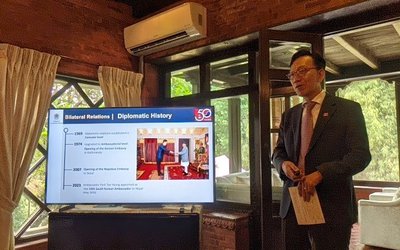During yesteryears the rice that was in vogue was the Masino for those at the top and Usineko for the common folk. Later one heard of Mansuli, Pokhreli, Buda Subba, Sanu & Jeera Masino and Urza or parboiled. Initially Nepal was an exporter of rice to India. Following the ushering of Green Revolution by Swaminathan in India, we now import Basmati from there and Taichin from China. Even after celebrating 15th Asar as Paddy Plantation Day for fifteen years and introduction of high yielding variety of seeds and fertilizers, our annual production is barely 5 to 6 million tons An archaic method of tilling with oxen and plough plus dependency on the monsoons still exists. Changes are essential if progress is to be made. Mechanization, is said to be under consideration to increase yields, Setting ducks loose at regular intervals to eat worms, insects and weeds to thereby increase yields is in practice in Japan. Restriction of rice /paddy imports from foreign lands to protect local interests is also enforced. One recollects that during the Panchayat days with an influx of water, carp fish farming was even done in Nepal,
The recent announcement in a state media of an exports surge in Nepal is a misnomer. When one looks closely at the figures one sees that the major share of this was due to the export of Palm Oil which was being brought into the country and then repackaged and sent out again. A similar instance was that of nylon yarn. Carpet exports were third but the garment industry is one which in spite of America’s kindness has still to pick up sales. Other items such as suparis and cardamom are said to be items of ‘Edhar ka Udhar aur Udhar ka Eidhr.’
Napoleon once said ‘England was a nation of shopkeepers’. During the time of Colonial rule, the British took the raw products such as cotton, cane and tea by ship from their colonies to England, refined it and sent the finished items to be sold at a higher price in the countries of origin. Labourers in the colonies were paid a pittance but the cost of the higher labour of the finished product had to be borne by the natives who had initially labored for it! Same pattern was prevalent in mining and other areas.
Our new government must see to it that the people who are producing the grains, fruits vegetables, milk, poultry and its products are given preference for sales within the country. This means putting restrictions on the activities of importers of cheaper and less standard products from outside. Such items should be taxed to make them more expensive that local produce or products.
During the erstwhile Rana days Nepal was said to be an exporter of timber and rice. This saying is now as obsolete as Ram Rajya to say the least. Jumla is now coming to the forefront these days by way of its products viz. apples – rosy red, marshi red rice and yarshagumba! In fact two red party leaders made national headlines when they had a meal of Jumla red rice at a house in MadyapurThimi whilst debating the pros and cons of a medical centre. The outcome of that consultation has still to be seen as two of the involved are currently out of step. The sale of Jumla Marshi (Red) chamal has increase because of the publicity.
Quinoa, the current craze of some Kathmandu dwellers is the edible seeds of a flowering plant of the amaranth family in South America. Its popularity is paying many dividends to its cultivators. The Yacon plant is also of similar origin and grows well in Nepal. Yacon means water root in the Inca language and it tastes like a mixture of apple, celery and watermelon. Known as Bhain Shau in Nepali it is claimed to reduce blood sugar in some diabetics.
There has always been talk of exotic cuisines such as bird’s nest soup, haggis, pirana fishes dish or even the special civet coffee. This coffee is said to have extraordinary taste as it has been partially digested in the intestine of the Asian civet. However the fact remains that it is the many edible legume seeds which are of much demand as a good source of protein. Our channa, or horse gram is said to give the saish or even the cycle-rickshaw peddler the stamina of a horse too! The stress should be on geda guddis and those from mountainous areas such a Jumla must be popularised for beneficial nutrition in the population. Quanti, a culturally accepted combination of legumes must be further popularised. Poppy seeds are used for the making of various delicacies. Both flax and hemp seeds have been in use as edibles in our part of the world. Our nutritional experts should be consulted on this aspect. Both plants have other uses too and so should be popularised. Furthermore instead of refined white flour bread or polished white rice we should be eating the normal natural cereals for reasons of our health.
As stated earlier the increased demand of meat of steers, pigs and chickens has led to great difficulties in the disposal of their dung or droppings. The huge amount of this is said to a contributor to the global warming. Energy from coal or diesel sources must be decreased. Various measures are being taken to reduce gas emissions from iron and steel industries and even from the exhaust fumes of planes and cars. A NotCo concern of Chile is producing from various plant based proteins alternatives to meat, eggs and even milk. This is not surprising for the flesh of animals has developed from the grass that it has grazed on! NotCo produce have been in the market in Chile and are being introduced to the US.
The future is in the use of seeds and cereals. The easiness of growing on the slopes of the small land holding in the mountains means that we must promote such seeds for general mass consumption by us Nepalis.
The author is a retired medical doctor and writes fiction under the pen name of Mani Dixit also. Website: www.hdixit.org.np. Twitter: @manidixithd

Hemang Dixit
The author writes fiction under the name of Mani Dixit. Website: www.hdixit.org.np. Twitter: @manidixithd
- Top Heavy
- Sep 20, 2023
- Most Able?
- Sep 04, 2023
- Changing Times
- Aug 21, 2023
- Nepali Shenanigans
- Aug 03, 2023
- Budget Naataks
- Jun 29, 2023















